-
-
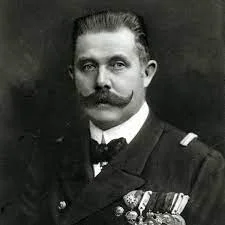 Frans Ferdinand was assassinated on June 28, 1914, in Sarajevo, which is now a part of Bosnia and Herzegovina. He and his wife were shot by a young Bosnian Serb nationalist named Gavrilo Princip. Ferdinand was assassinated because he was targeted by a group of nationalist who wanted Bosnia to be independent from Austria-Hungary.
Frans Ferdinand was assassinated on June 28, 1914, in Sarajevo, which is now a part of Bosnia and Herzegovina. He and his wife were shot by a young Bosnian Serb nationalist named Gavrilo Princip. Ferdinand was assassinated because he was targeted by a group of nationalist who wanted Bosnia to be independent from Austria-Hungary. -
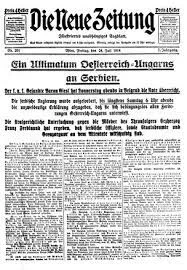 Austria's ultimatum to Serbia was set of demands given by Austria-Hungary to Serbia. Austria-Hungary accused Serbia of supporting terroism and gave them a list of conditions to meet within 48 hours. The ultimatum included Serbia sepressing anti-Austrian activities, allowing Austrian officials to investigate the assassination of Archduke Franz Ferdinand, and more.
Austria's ultimatum to Serbia was set of demands given by Austria-Hungary to Serbia. Austria-Hungary accused Serbia of supporting terroism and gave them a list of conditions to meet within 48 hours. The ultimatum included Serbia sepressing anti-Austrian activities, allowing Austrian officials to investigate the assassination of Archduke Franz Ferdinand, and more. -
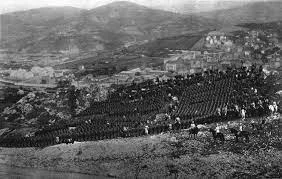 The war outbreak between Austria and Serbia refers to the conflict that occured after Austria-Hungary declared war on Serbia in 1914. This happened in response to the assassination of Archduke Franz Ferdinand, which Austria blamed on Serbian nationalists. The war escalated and eventually invloved multiple countries.
The war outbreak between Austria and Serbia refers to the conflict that occured after Austria-Hungary declared war on Serbia in 1914. This happened in response to the assassination of Archduke Franz Ferdinand, which Austria blamed on Serbian nationalists. The war escalated and eventually invloved multiple countries. -
 Germany declared war on Russia and France, it marked the beginning of a larger conflict known as World War 1. This war involved many countries and lasted from 1914 to 1918.
Germany declared war on Russia and France, it marked the beginning of a larger conflict known as World War 1. This war involved many countries and lasted from 1914 to 1918. -
 The Schliefen Plan, named after German Alfred von Schliefen, was a military strategy developed by Germany before World War 1. It aimed to quickly defeat France in the west while Germany focused most of its forces on the Eastern Front against Russia. The plan involved a rapid invasion of France through a Belgium, with the goal of encircling and capturing Paris. However, the plan didn't go as expected, and the war became a prolonged.
The Schliefen Plan, named after German Alfred von Schliefen, was a military strategy developed by Germany before World War 1. It aimed to quickly defeat France in the west while Germany focused most of its forces on the Eastern Front against Russia. The plan involved a rapid invasion of France through a Belgium, with the goal of encircling and capturing Paris. However, the plan didn't go as expected, and the war became a prolonged. -
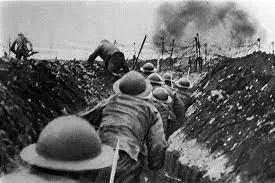 The Battle of the Marne took place in September 1914, near the Marne River in France. The battle was a major turning point in the war and marked the end of the German advance towards Paris. The French and British forces successfully halted the German offensive, leading to a stalemate on the Western Front. The battle lasted for several days and involved intense fighting and strategic maneuvers.
The Battle of the Marne took place in September 1914, near the Marne River in France. The battle was a major turning point in the war and marked the end of the German advance towards Paris. The French and British forces successfully halted the German offensive, leading to a stalemate on the Western Front. The battle lasted for several days and involved intense fighting and strategic maneuvers. -
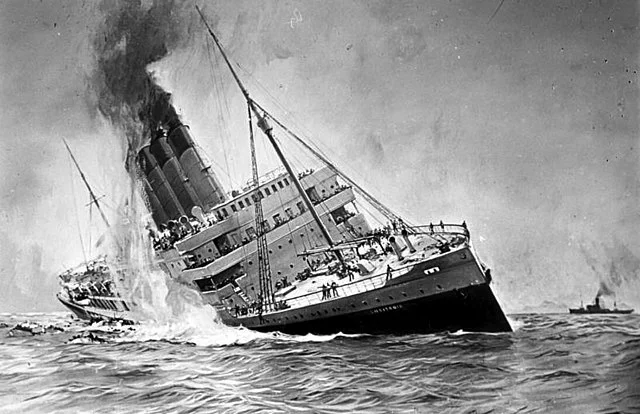 On May 7th, 1915, the British ocean liner Lusitania was torpedoed by a German submarine off the coast of Ireland. It caused the deaths of over 1,100 passengers, including 128 Americans. This act greatly impacted public opinion and contributed to the United States eventually joining the war.
On May 7th, 1915, the British ocean liner Lusitania was torpedoed by a German submarine off the coast of Ireland. It caused the deaths of over 1,100 passengers, including 128 Americans. This act greatly impacted public opinion and contributed to the United States eventually joining the war. -
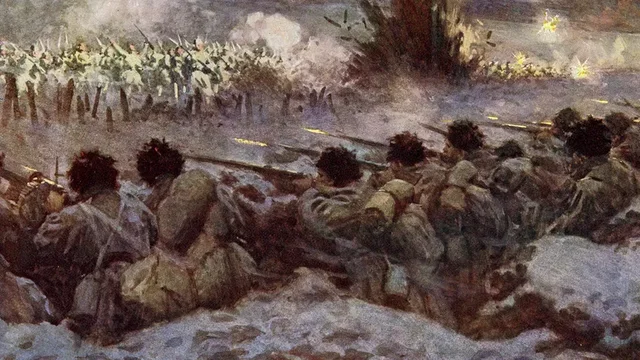 Battle of Verdun was a major battle of World War 1. It took place 1916 between the German and French armines. It was one of the longest and bloodiest battles in history. The Germans launches massive offensive, but the French held their ground and eventually pushed the Germans back. The German abd French armies clashed for nearly 10 months.
Battle of Verdun was a major battle of World War 1. It took place 1916 between the German and French armines. It was one of the longest and bloodiest battles in history. The Germans launches massive offensive, but the French held their ground and eventually pushed the Germans back. The German abd French armies clashed for nearly 10 months. -
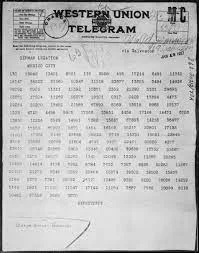 The Zimmermann Telegram was a secret message sent in 1917 by Germany to Mexico, propsing a military alliance against the United States. The telegram was intercepted and decoded by the British, who then shared it with the United State.
The Zimmermann Telegram was a secret message sent in 1917 by Germany to Mexico, propsing a military alliance against the United States. The telegram was intercepted and decoded by the British, who then shared it with the United State. -
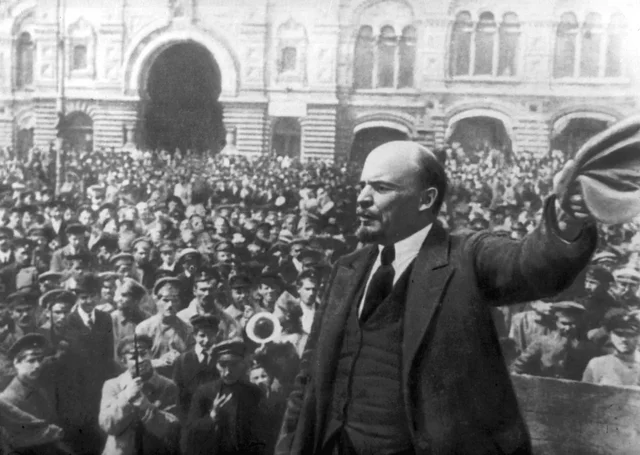 The Russian Revolution was a series of political and social upheavals that took place in Russia during the early 20th century. It ultimately led to the establishment of the Soviet Union. It was sparked by a combination of factors, including food shortages, military failures, etc.. The Russian Revolution had a impact on Russia and the world. It led to a civil war between the Bolsheviks and their opponents, which lasted until 1922.
The Russian Revolution was a series of political and social upheavals that took place in Russia during the early 20th century. It ultimately led to the establishment of the Soviet Union. It was sparked by a combination of factors, including food shortages, military failures, etc.. The Russian Revolution had a impact on Russia and the world. It led to a civil war between the Bolsheviks and their opponents, which lasted until 1922. -
 The United States maintained a policy of neutrality and did not want to get involved in the conflict. The factors that pushed U.S to join the war was the Zimmerman Telegram, Germany's unrestricted submarine warfare, and the support for the allied powers.
The United States maintained a policy of neutrality and did not want to get involved in the conflict. The factors that pushed U.S to join the war was the Zimmerman Telegram, Germany's unrestricted submarine warfare, and the support for the allied powers. -
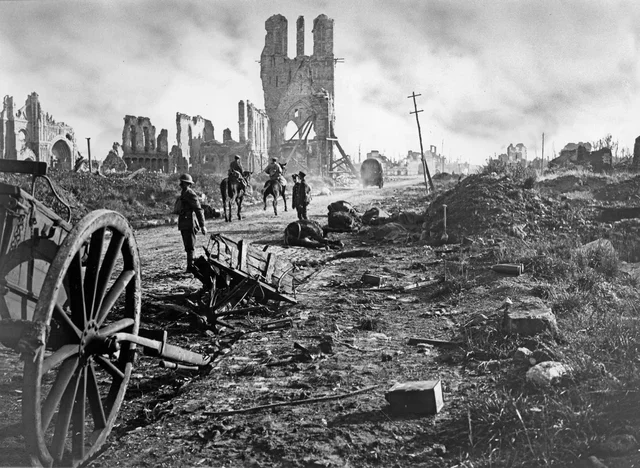 The Battle do the Passchendaele took place from July to Novemeber 1917, in the region of Ypres, Belgium. It was fought between the Allied forces, mainly British and Canadian troops, and the German forces. The battle was known for its extremely difficult conditions, with heavy rain turning the battlefield into a muddy quagmire.
The Battle do the Passchendaele took place from July to Novemeber 1917, in the region of Ypres, Belgium. It was fought between the Allied forces, mainly British and Canadian troops, and the German forces. The battle was known for its extremely difficult conditions, with heavy rain turning the battlefield into a muddy quagmire. -
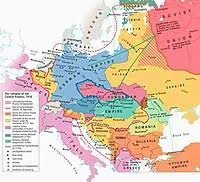 The Collapse of the Central Powers were made up of Germany, Austria-Hungary, the Ottoman Empire, and Bulgaria during World War 1. The Central Powers were facing significant losses on the battlefield. The Allied forces, including countries like Britain, France, and the United States, were gaining momentum and pushing back the Central Powers.
The Collapse of the Central Powers were made up of Germany, Austria-Hungary, the Ottoman Empire, and Bulgaria during World War 1. The Central Powers were facing significant losses on the battlefield. The Allied forces, including countries like Britain, France, and the United States, were gaining momentum and pushing back the Central Powers. -
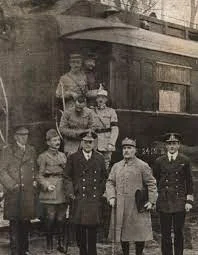 The armistice was an agreement that ended the fighting in World War 1. It was signed on November 11, 1918, and marked the official end of the war. The armistice was signed in a railway carriage in the Forest of Compiegne, France, between the Allies and Germany. It was negotiated by representives from both sides, with Marshal Ferdinand Foch representing the Allied Forces and Matthias Erzberger representing Germany.
The armistice was an agreement that ended the fighting in World War 1. It was signed on November 11, 1918, and marked the official end of the war. The armistice was signed in a railway carriage in the Forest of Compiegne, France, between the Allies and Germany. It was negotiated by representives from both sides, with Marshal Ferdinand Foch representing the Allied Forces and Matthias Erzberger representing Germany. -
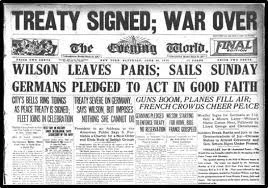 Treaty of Versailles was a significant agreement that was signed after the World War 1. It was signed on June 28th, 1919, in the Palace of Versailles, France. The treaty was primarily aimed at assigning blame for the war and imposing penalties on Germany. It placed full responsibilty for the war on Germany and its allies, known as the Central Powers.
Treaty of Versailles was a significant agreement that was signed after the World War 1. It was signed on June 28th, 1919, in the Palace of Versailles, France. The treaty was primarily aimed at assigning blame for the war and imposing penalties on Germany. It placed full responsibilty for the war on Germany and its allies, known as the Central Powers.